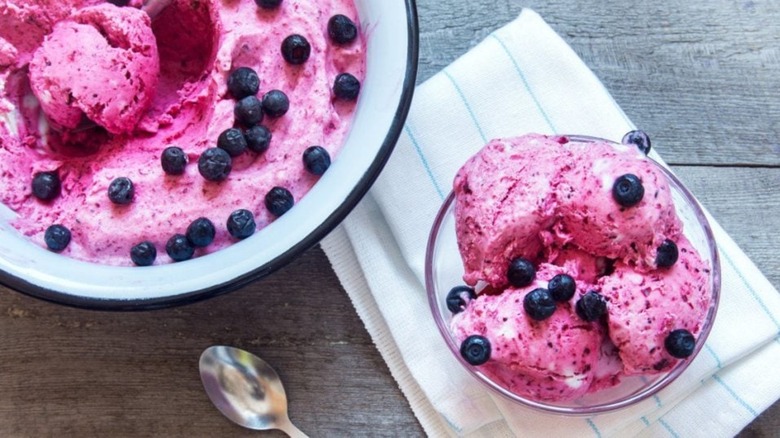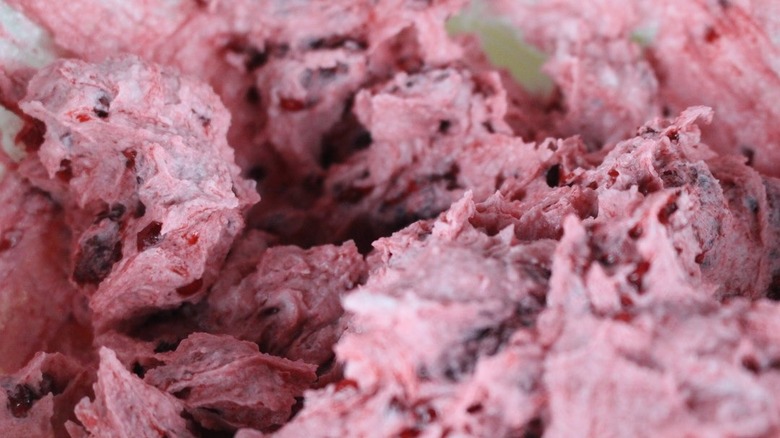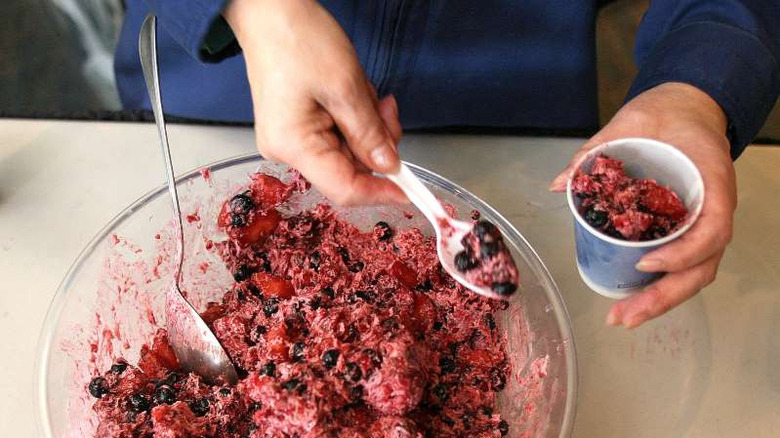Alaskan Akutaq Is A Unique Ice Cream Featuring Animal Fat
In the cold northern reaches of Alaska, there is an indigenous dish that, at first glance, looks like a typical offering from an ice cream parlor. In fact, many non-natives have taken to calling it "Eskimo ice cream."Its proper name is akutaq (also spelled "akutuq"), pronounced AUK-goo-duck, and when you realize what it's made of, you might question whether the ice cream label really applies, or whether you've come across something wholly unique in itself. Most of us exclusively associate ice cream with sweetness, and indeed, the most popular ice cream flavors among Americans all lean toward a sweet tooth. Akutaq is not so straightforward. It can be made with many different things including sweet berries, but the flavor profile is heavily influenced by a different ingredient: Animal fat.
To an outsider, the idea of making ice cream with animal fat might sound odd, but if you think about it for a moment, cream is largely composed of fat to begin with. The basic structure of akutaq, as well as the method used to make it, is very similar to ice cream, both being an emulsion of fat and water with air bubbles whipped into it for texture. But akutaq also differs from your typical ice cream in significant ways, beginning with its complex ties to indigenous history and modern challenges. It is also a far more versatile dish, whose many iterations vary wildly from region to region, depending on each cook's local resources. In short, akutaq is not one thing; it is many.
Akutaq means to stir
Akutaq is an Inupiaq word, coming from the large Inuit-Yupik-Unangax̂ family of languages. Translated to English, it means "to stir" or "mix together," alluding to the method used for making the dish. Akutaq begins with fat and oil, which were generally whipped together with a bit of snow or water until the mixture resembles frosting. This must be done vigorously, trapping air bubbles in between molecules of fat, so that the dish dramatically increases in volume while taking on a light texture. These days, many people use an electric mixture for the job, but traditionally, akutaq is whipped by hand, a laborious process that can take close to an hour. Once the fat mixture is the right consistency, ingredients are added for flavoring, with berries — particularly salmonberries — being the traditional choice. Sugar has been added to the dish since the mid-1800s when whalers first introduced it to the indigenous locals.
The ingredients of akutaq differ between regions. In northern Alaska, it is traditional to use two kinds of fat: The hard fat of a land mammal such as caribou, muskox, or bear, along with the oil of an aquatic mammal such as a seal or whale. In Alaska's southwest, however, akutaq is made with the oil of candlefish (also known as eulachon), which creates an extremely delicate product that can only hold its shape for a few minutes before falling apart. If meat is swapped in for the berries in akutaq, it transforms into the protein-rich staple known as pemmican, an important indigenous survival food.
Akutaq is changing with time
Akutaq's exact origins are unknown, as the Inupiaq historically lacked a written language, preferring to pass down customs through hands-on learning. Some believe it may have come from the first humans to ever set foot in North America after crossing the Bering Strait. Whenever and wherever it began, akutaq has steadily evolved throughout history, changing in accordance with the opportunities and challenges faced by Native Alaskans.
For centuries, the Inupiaq and neighboring Yup'ik would engage in annual trade fairs, with individuals traveling as far as 600 miles on foot, dogsled, or boat to attend. Such fairs also saw coastal residents and inlanders exchange seal oil for caribou fat, equipping one another with the necessities for making akutaq. At one event in 1842, spousal teams (with the wives shouldering the work and the husbands shouting orders) competed to invent new versions of the dish, with beaver, otter, fish roe, and blood all making appearances.
Over the past century, akutaq has become less common, a fact that is complexly interwoven with Native Alaskan gender roles. Historically, men hunted whatever regional animals that were used in the local akutaq variant. Women traditionally worked at home, rendering the animal fat and making the akutaq itself. These days, more women have joined the workforce, and the diet of Inupiaq and other indigenous groups has moved away from traditional fare to other cuisines. Nevertheless, akutaq doesn't show signs of vanishing. Many still make it at home, and Native-run eateries, such as the dining services at the Alaska Native Medical Center, have it on the menu.


